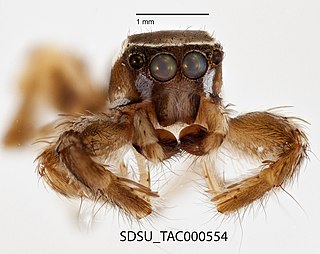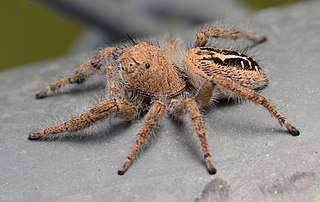 W
WCyclosa argenteoalba, in the trashline orbweavers genus, is a species of orb weaver in the spider family Araneidae. It is found in China, Korea, Taiwan, Japan, and Russia. Each individual has a unique appearance due to their differences in the ratio of black to silver coloring on their abdomen. Parasitic larvae are often found attached to C. argenteoalba, and the larvae are able to manipulate the spider’s behavior. During mating, female genital mutilation is common in order to increase the fitness of the male. On their webs, they often attach silk “decorations” that are thought to deter predators. Relocating to a different place to build a new web occurs frequently until they find a location with a significant amount of prey.
 W
WHabronattus formosus is a species of jumping spider in the family Salticidae. It is found in the United States.
 W
WHakka himeshimensis is a species of the spider family Salticidae. It is the only species in the genus Hakka. H. himeshimensis is native to East Asia, but has been introduced to the United States. It is most commonly found in rocky coastal habitats.
 W
WLariniaria is a genus of Asian orb-weaver spiders containing the single species, Lariniaria argiopiformis. It was first described by M. Grasshoff in 1970, and has only been found in Russia, China, Korea, and Japan.
 W
WPhidippus texanus is a species of jumping spider in the family Salticidae. It is found in the United States and Mexico.
 W
WProchora praticola is a species of spider in the family Miturgidae. It is found in China, Korea, and Japan, and was first described by Friedrich Wilhelm Bösenberg and Embrik Strand in 1906 as Agroeca praticola.
 W
WYaginumia is a genus of Asian orb-weaver spiders described by Allan Frost Archer to hold the single species, Yaginumia sia. This species was moved from Aranea to Zygiella in 1942, before moving to this genus in 1960. It has only been found in China, Korea, Taiwan, and Japan.